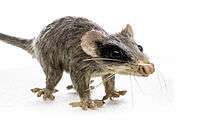Alphadon
| Alphadon Temporal range: Late Cretaceous | |
|---|---|
 | |
| Alphadon sp., reconstruction (MUSE - Science Museum of Trento) | |
| Scientific classification | |
| Kingdom: | Animalia |
| Phylum: | Chordata |
| Class: | Mammalia |
| Superorder: | Metatheria |
| Family: | Alphadontidae |
| Genus: | Alphadon |
| Species[1] | |
| |
Alphadon (meaning “first tooth”)[2] was a genus of small, primitive mammal that was a member of the metatherians, a group of mammals that includes modern-day marsupials. Its fossils were first discovered and named by George Gaylord Simpson in 1929.
Not much is known of its appearance as it is only known from teeth. It probably grew to about 12 in (30 cm) and may have resembled a modern opossum. Judging from its teeth, it was likely an omnivore, feeding on fruits, invertebrates and possibly small vertebrates.[2]
Alphadon lived during the end of the late Cretaceous period, alongside dinosaurs such as Tyrannosaurus and Triceratops. Its fossils have been found across North America, ranging from as far north as Alberta, Canada, to as far south as New Mexico in the United States.[2]
The type species is A. marshi.[2]
The species Nortedelphys jasoni was originally described as a species of the genus Alphadon by Storer (1991); however, it was subsequently transferred to the herpetotheriid genus Nortedelphys.[3]
Recent phylogenetic studies group it with other northern non-marsupial metatherians, Albertatherium and Turgidodon.[4][5]
Notes
- ↑ Mikko's 2003
- 1 2 3 4 Enchanted Learning 2010
- ↑ Thomas E. Williamson; Stephen L. Brusatte; Thomas D. Carr; Anne Weil; Barbara R. Standhardt (2012). "The phylogeny and evolution of Cretaceous–Palaeogene metatherians: cladistic analysis and description of new early Palaeocene specimens from the Nacimiento Formation, New Mexico". Journal of Systematic Palaeontology. 10 (4): 625–651. doi:10.1080/14772019.2011.631592.
- ↑ Guillermo W. Rougier; Brian M. Davis; Michael J. Novacek (2015). "A deltatheroidan mammal from the Upper Cretaceous Baynshiree Formation, eastern Mongolia". Cretaceous Research. 52, Part A: 167–177. doi:10.1016/j.cretres.2014.09.009.
- ↑ S. Bi, X. Jin, S. Li and T. Du. 2015. A new Cretaceous metatherian mammal from Henan, China. PeerJ 3:e896
References
- Haaramo, Mikko (August 2003). "Alphadontidae". Mikko's Phylogeny Archive. Retrieved January 2013. Check date values in:
|access-date=(help) - "Dinosaur and Paleontology Dictionary". Enchanted Learning. 2010. Retrieved January 2013. Check date values in:
|access-date=(help) - Jehle, Martin (August 2005). "Marsupials: A southern success story". Paleocene mammals of the world. Retrieved January 2013. Check date values in:
|access-date=(help)